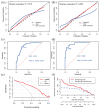Dispelling Mist That Obscures Positional Vertigo in Vestibular Migraine
- PMID: 37891854
- PMCID: PMC10605638
- DOI: 10.3390/brainsci13101487
Dispelling Mist That Obscures Positional Vertigo in Vestibular Migraine
Abstract
(1) Background: Patients with vestibular migraine (VM) often present with positional vertigo. A portion of these patients have features of benign paroxysmal positional vertigo (BPPV). It is a challenge to rapidly identify the BPPV component of VM associated with positional vertigo. (2) Methods: Retrospective data collected from 60 VM and 47 VM + BPPV patients were used to build a diagnostic model, and then prospective data from 47 patients were used for the external validation. All patients had VM manifesting as positional vertigo, with or without accompanying BPPV. The clinical manifestations and the results of vestibular function tests were comprehensively analyzed using logistic regression. (3) Results: The univariate and multivariate analyses showed that the age, symptom duration, tinnitus, ear fullness, nausea, head shaking nystagmus, the direction of the Dix-Hallpike and roll tests, and horizontal gain could help differentiate between the two groups. A nomogram and an online calculator were generated. The C-index was 0.870. The diagnostic model showed good discriminative power and calibration performance during internal and external validation. (4) Conclusions: This study provided a new perspective for diagnosing VM with positional vertigo by identifying the BPPV component and, for the first time, offers a prediction model integrating multiple predictors.
Keywords: benign paroxysmal positional vertigo; differential diagnosis; positional nystagmus; prediction model; vestibular migraine.
Conflict of interest statement
The authors declare no conflict of interest.
Figures




References
-
- Mallampalli M.P., Rizk H.G., Kheradmand A., Beh S.C., Abouzari M., Bassett A.M., Buskirk J., Ceriani C.E.J., Crowson M.G., Djalilian H., et al. Care Gaps and Recommendations in Vestibular Migraine: An Expert Panel Summit. Front. Neurol. 2021;12:812678. doi: 10.3389/fneur.2021.812678. - DOI - PMC - PubMed
Grants and funding
LinkOut - more resources
Full Text Sources

